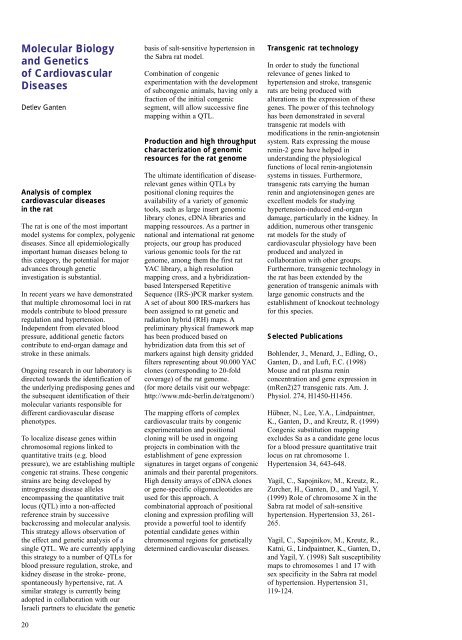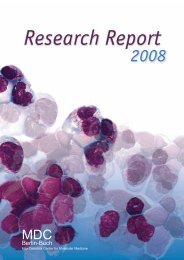Create successful ePaper yourself
Turn your PDF publications into a flip-book with our unique Google optimized e-Paper software.
Molecular Biology<br />
and Genetics<br />
of Cardiovascular<br />
Diseases<br />
Detlev Ganten<br />
Analysis of complex<br />
cardiovascular diseases<br />
in the rat<br />
The rat is one of the most important<br />
model systems for complex, polygenic<br />
diseases. Since all epidemiologically<br />
important human diseases belong to<br />
this category, the potential for major<br />
advances through genetic<br />
investigation is substantial.<br />
In recent years we have demonstrated<br />
that multiple chromosomal loci in rat<br />
models contribute to blood pressure<br />
regulation and hypertension.<br />
Independent from elevated blood<br />
pressure, additional genetic factors<br />
contribute to end-organ damage and<br />
stroke in these animals.<br />
Ongoing research in our laboratory is<br />
directed towards the identification of<br />
the underlying predisposing genes and<br />
the subsequent identification of their<br />
molecular variants responsible for<br />
different cardiovascular disease<br />
phenotypes.<br />
To localize disease genes within<br />
chromosomal regions linked to<br />
quantitative traits (e.g. blood<br />
pressure), we are establishing multiple<br />
congenic rat strains. These congenic<br />
strains are being developed by<br />
introgressing disease alleles<br />
encompassing the quantitative trait<br />
locus (QTL) into a non-affected<br />
reference strain by successive<br />
backcrossing and molecular analysis.<br />
This strategy allows observation of<br />
the effect and genetic analysis of a<br />
single QTL. We are currently applying<br />
this strategy to a number of QTLs for<br />
blood pressure regulation, stroke, and<br />
kidney disease in the stroke- prone,<br />
spontaneously hypertensive, rat. A<br />
similar strategy is currently being<br />
adopted in collaboration with our<br />
Israeli partners to elucidate the genetic<br />
20<br />
basis of salt-sensitive hypertension in<br />
the Sabra rat model.<br />
Combination of congenic<br />
experimentation with the development<br />
of subcongenic animals, having only a<br />
fraction of the initial congenic<br />
segment, will allow successive fine<br />
mapping within a QTL.<br />
Production and high throughput<br />
characterization of genomic<br />
resources for the rat genome<br />
The ultimate identification of diseaserelevant<br />
genes within QTLs by<br />
positional cloning requires the<br />
availability of a variety of genomic<br />
tools, such as large insert genomic<br />
library clones, cDNA libraries and<br />
mapping ressources. As a partner in<br />
national and international rat genome<br />
projects, our group has produced<br />
various genomic tools for the rat<br />
genome, among them the first rat<br />
YAC library, a high resolution<br />
mapping cross, and a hybridizationbased<br />
Interspersed Repetitive<br />
Sequence (IRS-)PCR marker system.<br />
A set of about 800 IRS-markers has<br />
been assigned to rat genetic and<br />
radiation hybrid (RH) maps. A<br />
preliminary physical framework map<br />
has been produced based on<br />
hybridization data from this set of<br />
markers against high density gridded<br />
filters representing about 90.000 YAC<br />
clones (corresponding to 20-fold<br />
coverage) of the rat genome.<br />
(for more details visit our webpage:<br />
http://www.mdc-berlin.de/ratgenom/)<br />
The mapping efforts of complex<br />
cardiovascular traits by congenic<br />
experimentation and positional<br />
cloning will be used in ongoing<br />
projects in combination with the<br />
establishment of gene expression<br />
signatures in target organs of congenic<br />
animals and their parental progenitors.<br />
High density arrays of cDNA clones<br />
or gene-specific oligonucleotides are<br />
used for this approach. A<br />
combinatorial approach of positional<br />
cloning and expression profiling will<br />
provide a powerful tool to identify<br />
potential candidate genes within<br />
chromosomal regions for genetically<br />
determined cardiovascular diseases.<br />
Transgenic rat technology<br />
In order to study the functional<br />
relevance of genes linked to<br />
hypertension and stroke, transgenic<br />
rats are being produced with<br />
alterations in the expression of these<br />
genes. The power of this technology<br />
has been demonstrated in several<br />
transgenic rat models with<br />
modifications in the renin-angiotensin<br />
system. Rats expressing the mouse<br />
renin-2 gene have helped in<br />
understanding the physiological<br />
functions of local renin-angiotensin<br />
systems in tissues. Furthermore,<br />
transgenic rats carrying the human<br />
renin and angiotensinogen genes are<br />
excellent models for studying<br />
hypertension-induced end-organ<br />
damage, particularly in the kidney. In<br />
addition, numerous other transgenic<br />
rat models for the study of<br />
cardiovascular physiology have been<br />
produced and analyzed in<br />
collaboration with other groups.<br />
Furthermore, transgenic technology in<br />
the rat has been extended by the<br />
generation of transgenic animals with<br />
large genomic constructs and the<br />
establishment of knockout technology<br />
for this species.<br />
Selected Publications<br />
Bohlender, J., Menard, J., Edling, O.,<br />
Ganten, D., and Luft, F.C. (1998)<br />
Mouse and rat plasma renin<br />
concentration and gene expression in<br />
(mRen2)27 transgenic rats. Am. J.<br />
Physiol. 274, H1450-H1456.<br />
Hübner, N., Lee, Y.A., Lindpaintner,<br />
K., Ganten, D., and Kreutz, R. (1999)<br />
Congenic substitution mapping<br />
excludes Sa as a candidate gene locus<br />
for a blood pressure quantitative trait<br />
locus on rat chromosome 1.<br />
Hypertension 34, 643-648.<br />
Yagil, C., Sapojnikov, M., Kreutz, R.,<br />
Zurcher, H., Ganten, D., and Yagil, Y.<br />
(1999) Role of chromosome X in the<br />
Sabra rat model of salt-sensitive<br />
hypertension. Hypertension 33, 261-<br />
265.<br />
Yagil, C., Sapojnikov, M., Kreutz, R.,<br />
Katni, G., Lindpaintner, K., Ganten, D.,<br />
and Yagil, Y. (1998) Salt susceptibility<br />
maps to chromosomes 1 and 17 with<br />
sex specificity in the Sabra rat model<br />
of hypertension. Hypertension 31,<br />
119-124.

















